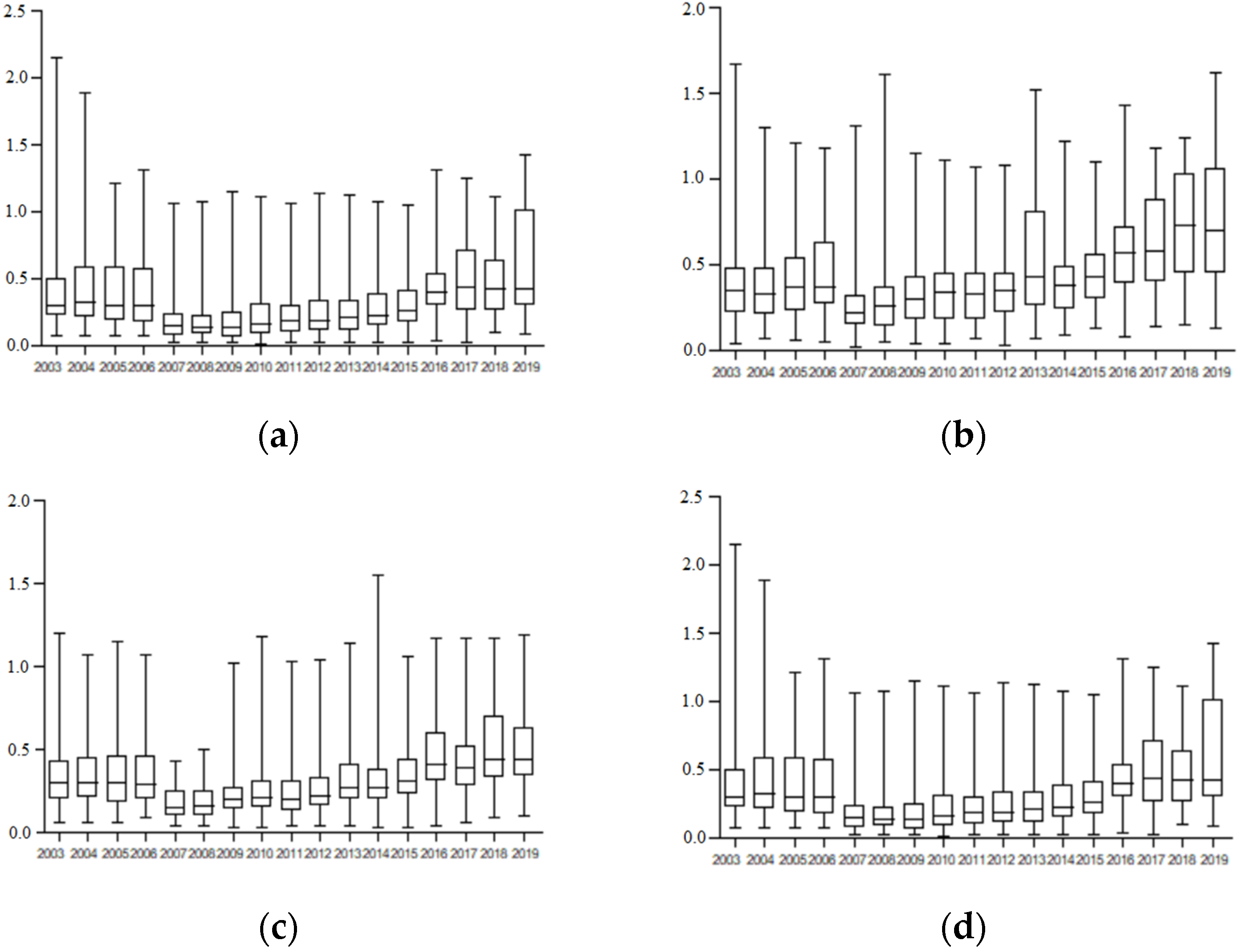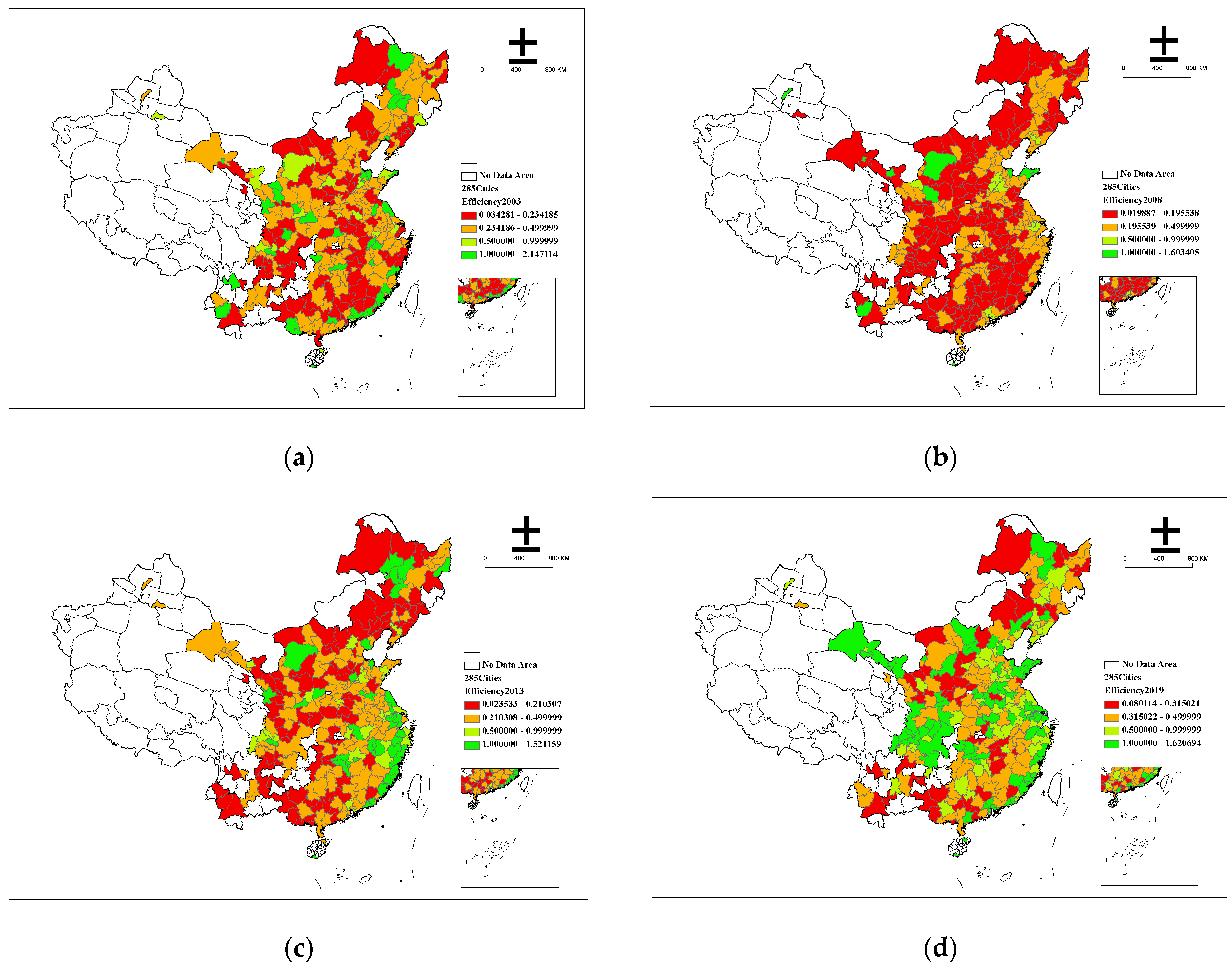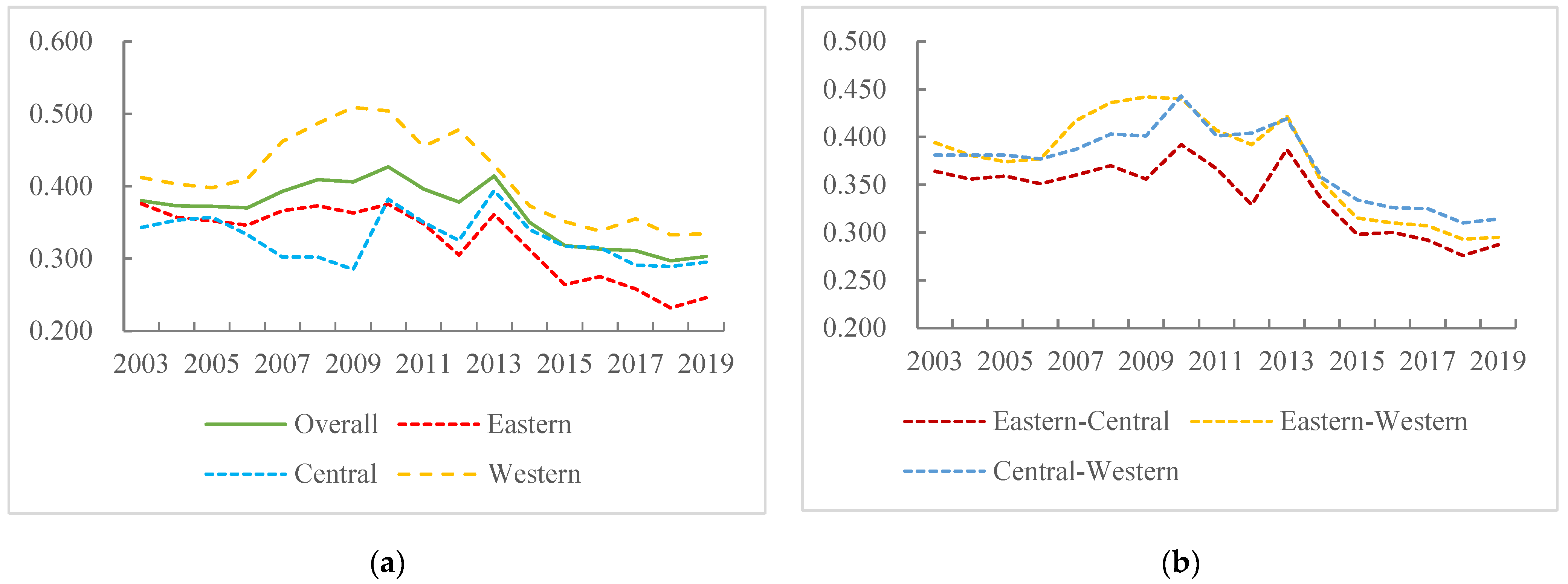Regional Differences and Influencing Factors of Green Innovation Efficiency in China’s 285 Cities
Abstract
:1. Introduction
2. Literature Review
2.1. Measurement of GIE
2.2. Regional Difference in GIE
2.3. Influencing Factors of GIE
3. Methods and Data
3.1. Methods
3.1.1. Super-Efficiency SBM-DEA Model with Undesirable Outputs
3.1.2. Dagum’s Gini Coefficient Decomposition
3.1.3. Kernel Density Estimation
3.1.4. Spatial Auto-Correlation Method
3.1.5. Spatial Econometric Model
3.2. Variables Selection and Data Sources
4. Results and Discussions
4.1. Results of GIE Measurement
4.2. Regional Differences in GIE
4.3. Distribution Dynamics of GIE
4.4. Influencing Factors of GIE
5. Discussion
6. Conclusions and Policy Implications
6.1. Conclusions
6.2. Policy Implications
6.3. Study Limitations
Author Contributions
Funding
Institutional Review Board Statement
Informed Consent Statement
Data Availability Statement
Conflicts of Interest
References
- Song, M.; Peng, L.; Shang, Y.; Zhao, X. Green technology progress and total factor productivity of resource-based enterprises: A perspective of technical compensation of environmental regulation. Technol. Forecast. Soc. Chang. 2022, 174, 121276. [Google Scholar] [CrossRef]
- Zhu, Q.; Li, X.; Li, F.; Zhou, D. The potential for energy saving and carbon emission reduction in China’s regional industrial sectors. Sci. Total Environ. 2020, 716, 135009. [Google Scholar] [CrossRef] [PubMed]
- Liu, J.; Jiang, Y.; Gan, S.; He, L.; Zhang, Q. Can digital finance promote corporate green innovation? Environ. Sci. Pollut. Res. 2022, 29, 35828–35840. [Google Scholar] [CrossRef] [PubMed]
- Arslan, Z.; Kausar, S.; Kannaiah, D.; Shabbir, M.S.; Khan, G.Y.; Zamir, A. The mediating role of green creativity and the moderating role of green mindfulness in the relationship among clean environment, clean production, and sustainable growth. Environ. Sci. Pollut. Res. 2021, 29, 13238–13252. [Google Scholar] [CrossRef] [PubMed]
- Wang, M.; Li, Y.; Li, J.; Wang, Z. Green process innovation, green product innovation and its economic performance improvement paths: A survey and structural model. J. Environ. Manag. 2021, 297, 113282. [Google Scholar] [CrossRef] [PubMed]
- Begum, S.; Xia, E.; Ali, F.; Awan, U.; Ashfaq, M. Achieving green product and process innovation through green leadership and creative engagement in manufacturing. J. Manuf. Technol. Manag. 2022, 33, 656–674. [Google Scholar] [CrossRef]
- Rennings, K. Redefining innovation—Eco-innovation research and the contribution from ecological economics. Ecol. Econ. 2000, 32, 319–332. [Google Scholar] [CrossRef]
- Wurlod, J.-D.; Noailly, J. The impact of green innovation on energy intensity: An empirical analysis for 14 industrial sectors in OECD countries. Energy Econ. 2018, 71, 47–61. [Google Scholar] [CrossRef]
- Luo, Q.; Miao, C.; Sun, L.; Meng, X.; Duan, M. Efficiency evaluation of green technology innovation of China’s strategic emerging industries: An empirical analysis based on Malmquist-data envelopment analysis index. J. Clean. Prod. 2019, 238, 117782. [Google Scholar] [CrossRef]
- Li, D.; Zeng, T. Are China’s intensive pollution industries greening? An analysis based on green innovation efficiency. J. Clean. Prod. 2020, 259, 120901. [Google Scholar] [CrossRef]
- Zhao, N.; Liu, X.; Pan, C.; Wang, C. The performance of green innovation: From an efficiency perspective. Socio-Econ. Plan. Sci. 2021, 78, 101062. [Google Scholar] [CrossRef]
- Zhao, P.; Lu, Z.; Kou, J.; Du, J. Regional differences and convergence of green innovation efficiency in China. J. Environ. Manag. 2023, 325, 116618. [Google Scholar] [CrossRef]
- Wang, K.-L.; Zhang, F.-Q.; Xu, R.-Y.; Miao, Z.; Cheng, Y.-H.; Sun, H.-P. Spatiotemporal pattern evolution and influencing factors of green innovation efficiency: A China’s city level analysis. Ecol. Indic. 2023, 146, 109901. [Google Scholar] [CrossRef]
- Simanaviciene, Z.; Kilijoniene, A.; Simanavicius, A.; Khadzhynov, I. Transformation of Lithuania and Ukraine regional policy. Econ. Cond. Enterp. Funct. 2014, 25, 350–359. [Google Scholar] [CrossRef]
- Cui, Y.; Khan, S.U.; Deng, Y.; Zhao, M. Regional difference decomposition and its spatiotemporal dynamic evolution of Chinese agricultural carbon emission: Considering carbon sink effect. Environ. Sci. Pollut. Res. 2021, 28, 38909–38928. [Google Scholar] [CrossRef] [PubMed]
- Seiford, L.M.; Zhu, J. Modeling undesirable factors in efficiency evaluation. Eur. J. Oper. Res. 2002, 142, 16–20. [Google Scholar] [CrossRef]
- Long, R.; Guo, H.; Zheng, D.; Chang, R.; Na, S. Research on the measurement, evolution, and driving factors of green innovation efficiency in yangtze river economic belt: A super-sbm and spatial durbin model. Complexity 2020, 2020, 8094247. [Google Scholar] [CrossRef]
- Liu, C.; Gao, X.; Ma, W.; Chen, X. Research on regional differences and influencing factors of green technology innovation efficiency of China’s high-tech industry. J. Comput. Appl. Math. 2020, 369, 112597. [Google Scholar] [CrossRef]
- Fan, F.; Lian, H.; Liu, X.; Wang, X. Can environmental regulation promote urban green innovation efficiency? An empirical study based on Chinese cities. J. Clean. Prod. 2021, 287, 125060. [Google Scholar] [CrossRef]
- Zhang, J.; Ouyang, Y.; Ballesteros-Perez, P.; Li, H.; Philbin, S.P.; Li, Z.; Skitmore, M. Understanding the impact of environmental regulations on green technology innovation efficiency in the construction industry. Sustain. Cities Soc. 2020, 65, 102647. [Google Scholar] [CrossRef]
- Rennings, K.; Ziegler, A.; Ankele, K.; Hoffmann, E. The influence of different characteristics of the EU environmental management and auditing scheme on technical environmental innovations and economic performance. Ecolog. Econ. 2006, 57, 45–59. [Google Scholar] [CrossRef]
- Zhang, N.; Deng, J.; Ahmad, F.; Draz, M.U. Local government competition and regional green development in China: The mediating role of environmental regulation. Int. J. Environ. Res. Public Health 2020, 17, 3485. [Google Scholar] [CrossRef] [PubMed]
- Huang, Y.; Wang, Y. How does high-speed railway affect green innovation efficiency? A perspective of innovation factor mobility. J. Clean. Prod. 2020, 265, 121623. [Google Scholar] [CrossRef]
- Tone, K. A slacks-based measure of efficiency in data envelopment analysis. Eur. J. Oper. Res. 2001, 130, 498–509. [Google Scholar] [CrossRef]
- Dagum, C. A new approach to the decomposition of the Gini income inequality ratio. Empir. Econ. 1997, 22, 515–531. [Google Scholar] [CrossRef]
- Rosenblatt, M. Remarks on some nonparametric estimates of a density function. Ann. Inst. Stat. Math. 1956, 27, 832–837. [Google Scholar] [CrossRef]
- Silverman, B.W. Density Estimation for Statistics and Data Analysis; Chapman and Hall: New York, NY, USA, 1986. [Google Scholar]
- Anselin, L.; Syabri, I.; Smirno, O. Visualizing multivariate spatial correlation with dynamically linked windows. In Proceedings of the CSISS Workshop on New Tools for Spatial Data Analysis, Santa Barbara, CA, USA, 10–11 May 2002. [Google Scholar]
- Elhorst, J.P. Applied spatial econometrics: Raising the bar. Spat. Econ. Anal. 2010, 5, 9–28. [Google Scholar] [CrossRef]
- Lu, C.; Chen, M.; Tian, G. Spatial-temporal evolution and influencing factors of urban green innovation efficiency in China. J. Environ. Public Health 2022, 2022, 4047572. [Google Scholar] [CrossRef]
- Zhou, H.; Wang, R. Exploring the impact of energy factor prices and environmental regulation on China’s green innovation efficiency. Environ. Sci. Pollut. Res. 2022, 29, 78973–78988. [Google Scholar] [CrossRef]
- Liu, K.; Xue, Y.; Chen, Z.; Miao, Y. The spatiotemporal evolution and influencing factors of urban green innovation in China. Sci. Total Environ. 2023, 857, 159426. [Google Scholar] [CrossRef]
- Li, L.; Lei, L.; Han, D. Regional green innovation efficiency in high-end manufacturing. J. Coast. Res. 2018, 82, 280–287. [Google Scholar] [CrossRef]
- Liao, B.; Li, L. Urban green innovation efficiency and its influential factors: The Chinese evidence. Environ. Dev. Sustain. 2023, 25, 6551–6573. [Google Scholar] [CrossRef]
- Lin, S.; Sun, J.; Marinova, D.; Zhao, D. Evaluation of the green technology innovation efficiency of China’s manufacturing industries: DEA window analysis with ideal window width. Technol. Anal. Strateg. 2018, 30, 1166–1181. [Google Scholar] [CrossRef]
- Zhang, L.; Ma, X.; Ock, Y.-S.; Qing, L. Research on regional differences and influencing factors of Chinese industrial green technology innovation efficiency based on Dagum Gini coefficient decomposition. Land 2022, 11, 122. [Google Scholar] [CrossRef]
- Yao, M.; Duan, J.; Wang, Q. Spatial and temporal evolution analysis of industrial green technology innovation efficiency in the Yangtze River Economic Belt. Int. J. Environ. Res. Public Health 2022, 19, 6311. [Google Scholar] [CrossRef] [PubMed]
- Guo, Y.; Tong, L.; Mei, L. The effect of industrial agglomeration on green development efficiency in Northeast China since the revitalization. J. Clean. Prod. 2020, 258, 120584. [Google Scholar] [CrossRef]
- Wu, F.; Fu, X.; Zhang, T.; Wu, D.; Sindakis, S. Examining whether government environmental regulation promotes green innovation efficiency—Evidence from China’s Yangtze River Economic Belt. Sustainability 2022, 14, 1827. [Google Scholar] [CrossRef]
- Liu, P.; Luo, Z. A measurement and analysis of the growth of urban green total factor productivity-based on the perspective of energy and land elements. Front. Environ. Sci. 2022, 10, 838748. [Google Scholar] [CrossRef]
- Long, X.; Sun, C.; Wu, C.; Chen, B.; Boateng, K.A. Green innovation efficiency across China’s 30 provinces: Estimate, comparison, and convergence. Mitig. Adapt. Strateg. Glob. Chang. 2019, 25, 1243–1260. [Google Scholar] [CrossRef]
- Guo, J.; Fu, Y.; Sun, X. Green innovation efficiency and multiple paths of urban sustainable development in China: Multi-configuration analysis based on urban innovation ecosystem. Sci. Rep. 2023, 13, 12975. [Google Scholar] [CrossRef]
- Wu, Z.J.; Wu, N.J. Research on the Measurement, Decomposition and Influencing Factors of Green Economic Efficiency in the Yangtze River Economic Belt: Based on Super-Efficiency SBM-ML-Tobit Model. Urban Probl. 2021, 40, 52–62+89. [Google Scholar] [CrossRef]






| System Layer | Standard Layer | Indicator Layer | Unit |
|---|---|---|---|
| Input | Capital | Expenditure for science and technology | 10 million yuan |
| Expenditure for education | 10 million yuan | ||
| Labor | Number of urban employees | Person | |
| Number of scientific and technological personnel | Person | ||
| Energy | Electricity consumption resources | 10 million kw⋅h | |
| Desirable output | Economic development | Per capital GDP | Yuan |
| Innovation progress | Number of green patent applications | One | |
| Number of green utility model applications | One | ||
| Undesirable output | Environmental pollution | Industrial wastewater discharge | 10 million tons |
| Industrial SO2 emissions | Tons | ||
| Industrial smoke dust emissions | Tons |
| Year | Overall Gini Coefficient | Within-Region Gini Coefficient | Between-Region Gini Coefficient | Contribution (%) | ||||||
|---|---|---|---|---|---|---|---|---|---|---|
| Eastern | Central | Western | Eastern-Central | Eastern-Western | Central-Western | Gw | Gnb | Gt | ||
| 2003 | 0.380 | 0.376 | 0.343 | 0.412 | 0.364 | 0.394 | 0.381 | 33.020 | 11.368 | 55.611 |
| 2004 | 0.373 | 0.357 | 0.353 | 0.403 | 0.356 | 0.381 | 0.381 | 32.950 | 10.945 | 56.105 |
| 2005 | 0.372 | 0.352 | 0.357 | 0.398 | 0.359 | 0.374 | 0.381 | 32.927 | 12.808 | 54.266 |
| 2006 | 0.370 | 0.346 | 0.333 | 0.410 | 0.351 | 0.377 | 0.377 | 32.521 | 17.943 | 49.536 |
| 2007 | 0.393 | 0.366 | 0.302 | 0.462 | 0.360 | 0.417 | 0.387 | 31.815 | 26.821 | 41.364 |
| 2008 | 0.409 | 0.373 | 0.302 | 0.487 | 0.370 | 0.436 | 0.403 | 31.350 | 29.729 | 38.922 |
| 2009 | 0.406 | 0.363 | 0.285 | 0.509 | 0.356 | 0.442 | 0.401 | 30.936 | 26.832 | 42.232 |
| 2010 | 0.427 | 0.375 | 0.382 | 0.504 | 0.392 | 0.440 | 0.443 | 32.075 | 19.339 | 48.586 |
| 2011 | 0.396 | 0.348 | 0.350 | 0.455 | 0.367 | 0.407 | 0.401 | 31.804 | 24.806 | 43.391 |
| 2012 | 0.378 | 0.305 | 0.325 | 0.478 | 0.329 | 0.392 | 0.404 | 31.504 | 20.054 | 48.442 |
| 2013 | 0.414 | 0.361 | 0.394 | 0.429 | 0.387 | 0.422 | 0.419 | 31.651 | 33.727 | 34.623 |
| 2014 | 0.350 | 0.312 | 0.340 | 0.373 | 0.334 | 0.352 | 0.357 | 32.397 | 25.310 | 42.293 |
| 2015 | 0.318 | 0.264 | 0.317 | 0.351 | 0.298 | 0.315 | 0.334 | 32.024 | 22.655 | 45.321 |
| 2016 | 0.313 | 0.275 | 0.315 | 0.338 | 0.300 | 0.310 | 0.326 | 32.609 | 15.237 | 52.154 |
| 2017 | 0.311 | 0.258 | 0.291 | 0.355 | 0.292 | 0.307 | 0.325 | 31.549 | 26.306 | 42.145 |
| 2018 | 0.297 | 0.232 | 0.289 | 0.333 | 0.276 | 0.293 | 0.310 | 31.091 | 29.516 | 39.393 |
| 2019 | 0.303 | 0.246 | 0.295 | 0.334 | 0.287 | 0.295 | 0.314 | 31.426 | 27.247 | 41.327 |
| Overall | Eastern | Central | Western | |
|---|---|---|---|---|
| Cons | −0.016 | −0.002 | −0.035 | −0.048 |
| LnGDP | 0.331 *** | 0.066 | 0.392 *** | 0.526 *** |
| LnLGE | 0.430 *** | 0.205 ** | 0.415 *** | 0.607 *** |
| LnLFI | 0.061 | 0.157 ** | 0.047 | 0.042 |
| RTS | 0.120 *** | 0.074 ** | 0.290 *** | 0.099 |
| LnPOP | 0.068 * | −0.020 | 0.139 ** | 0.031 |
| LAMBDA | 0.225 * | 0.030 | 0.276 ** | 0.357 ** |
| R2 | 0.508 | 0.521 | 0.521 | 0.690 |
| Breusch-Pagan test | 17.718 *** | 12.496 ** | 12.006 ** | 11.657 ** |
| Likelihood Ratio test | 2.761 * | 0.026 | 2.088 | 2.286 |
Disclaimer/Publisher’s Note: The statements, opinions and data contained in all publications are solely those of the individual author(s) and contributor(s) and not of MDPI and/or the editor(s). MDPI and/or the editor(s) disclaim responsibility for any injury to people or property resulting from any ideas, methods, instructions or products referred to in the content. |
© 2023 by the authors. Licensee MDPI, Basel, Switzerland. This article is an open access article distributed under the terms and conditions of the Creative Commons Attribution (CC BY) license (https://creativecommons.org/licenses/by/4.0/).
Share and Cite
Shang, Y.; Niu, Y.; Song, P. Regional Differences and Influencing Factors of Green Innovation Efficiency in China’s 285 Cities. Sustainability 2024, 16, 334. https://doi.org/10.3390/su16010334
Shang Y, Niu Y, Song P. Regional Differences and Influencing Factors of Green Innovation Efficiency in China’s 285 Cities. Sustainability. 2024; 16(1):334. https://doi.org/10.3390/su16010334
Chicago/Turabian StyleShang, Yingshi, Yanmin Niu, and Peng Song. 2024. "Regional Differences and Influencing Factors of Green Innovation Efficiency in China’s 285 Cities" Sustainability 16, no. 1: 334. https://doi.org/10.3390/su16010334
APA StyleShang, Y., Niu, Y., & Song, P. (2024). Regional Differences and Influencing Factors of Green Innovation Efficiency in China’s 285 Cities. Sustainability, 16(1), 334. https://doi.org/10.3390/su16010334





